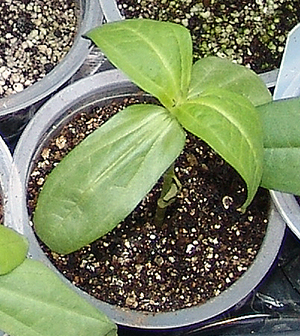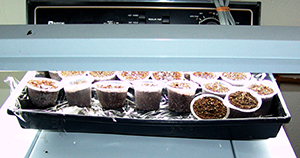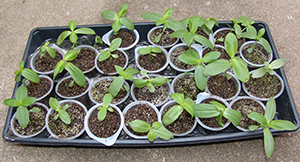Starting Your Own Seeds
Return to Miscellaneous Agent Articles
 It may be cold outside, but that doesn't mean you can´t start preparing for your spring garden.
It may be cold outside, but that doesn't mean you can´t start preparing for your spring garden.
If a vegetable garden is in your plans, then starting your own vegetable plants from seed makes a lot of sense, especially if you are planning a large garden. If a smaller garden is in your plans, collaborate with friends, family and neighbors to grow enough tomatoes, peppers and eggplants for everyone!
Maybe it's not about the numbers. Starting your own transplants can be fun and is a great way to scratch that gardening itch during the cloudy winter days. Whether it's vegetables or colorful annuals, the following instructions can help you get growing.
Timing is everything
In order for seedlings to be ready for planting day, you need to pay attention to the calendar. For spring planting, count backwards using the last frost date as a basic guideline. In KC, the average last frost date is April 15, which means you have a 50/50 chance of experiencing a damaging frost.
Mid-May or around Mother’s Day is considered safe to plant out crops that cannot tolerate a frost or need warm soil temperatures for best growth. This would include favorites such as tomatoes, peppers and zinnias.
Cool loving vegetables such as broccoli and cabbage will tolerate light freezes and need a longer cool growing period to produce. These vegetables are best planted from transplants in the garden around the end of March.
Deciding when to start can be a challenge. But keep in mind most garden transplants need around six to eight weeks of growth to be ready for outdoor planting. Determine the seed planting date by counting backwards on the calendar from your desired setting out date. Mid-May tomatoes should be seeded mid to late March. Cool-loving broccoli will be planted in mid to late February.
The amount of time transplants need to grow can vary greatly based on temperatures, so be sure to keep good notes. Warmer locations in the home will grow faster than a cooler room. The most common mistake most people make is starting too early and the plants become overgrown and straggly.
Light it up The key to success in starting seeds is providing plenty of good quality light. Once the seeds have germinated, they will need a bright, ample supply of light for at least 14 – 16 hours a day.
The key to success in starting seeds is providing plenty of good quality light. Once the seeds have germinated, they will need a bright, ample supply of light for at least 14 – 16 hours a day.
Placing the plants in a south facing window is not enough — they will stretch and become leggy. We have probably all learned this from experience as a child or adult. But don’t worry. You will not need to invest in fancy “grow lights” to get the job done.
Plain, ordinary shop lights with regular florescent bulbs will provide the needed light for your transplants. Suspend the lights just above the germinated seedlings, 2 to 4 inches above the top of them. As the plants grow, move the lights up higher but keep within about 4 inches of the top green growth. Suspending the lights from the ceiling, or a simple frame makes this easy to do. The key with the shop lights is that they provide bright, intense lighting for a long period of time which helps create short, stocky plants for the garden. A timer can become a life saver and make growing plants under lights more enjoyable. If you are new to starting seeds, start small. A single plastic seedling tray or small container is a good place to start in combination with an easy-to-grow-from-seed plant, such as tomatoes. Six packs in a typical tray will provide enough space for up to 72 plants.
If you are new to starting seeds, start small. A single plastic seedling tray or small container is a good place to start in combination with an easy-to-grow-from-seed plant, such as tomatoes. Six packs in a typical tray will provide enough space for up to 72 plants.
Starting transplants can be fun for the family so don't forget to include the kids in the experience as growing seeds is a terrific learning experience for creating lifelong memories.

